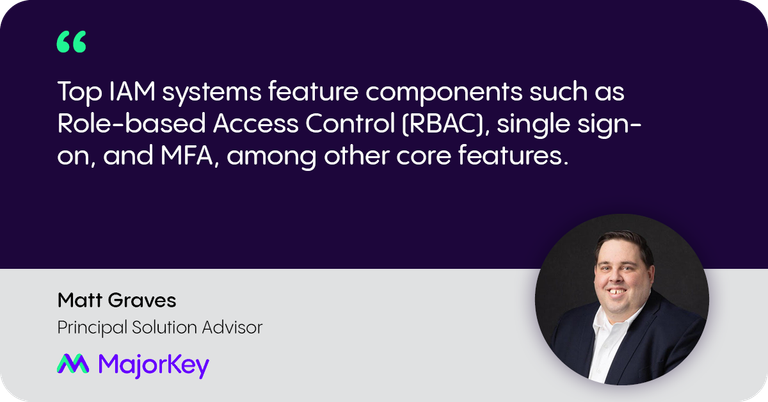
Blog
Matt Graves | January 11, 2024 I 6 min read
Components of Identity and Access Management (IAM) Systems
Identity and Access Management (IAM) systems are crucial for the security and efficiency of modern organizations. In an era where data breaches are increasingly common and the need for regulatory compliance is ever-growing, implementing a robust IAM system is more important than ever.
This blog post will cover the key components of IAM systems, highlighting their importance in the today’s digital landscape.
User Identity Management
At the core of any IAM system is the management of user identities. This component involves creating, maintaining, and managing user profiles and their corresponding identity data within the system. It includes the following:
- Provisioning of User Accounts: Creating accounts for new users and assigning the necessary access rights.
- Profile Management: Updating and managing user profiles as roles and responsibilities change.
- De-Provisioning: Removing access and deactivating accounts when employees leave the organization or change roles.
User Authentication
Authentication is the process of verifying a user’s identity. It is a critical step in ensuring that only authorized users gain access to systems and data. Some of the most popular methods include:
- Passwords: The most common form of authentication, though not the most secure.
- Multi-Factor Authentication (MFA): Involves two or more methods of verification, significantly increasing security.
- Biometric Verification: Utilizing fingerprints, facial recognition, or other biometric data for authentication.
User Authorization and Access Control
Once a user’s identity is authenticated, the IAM system must control what resources the user can access and what actions they can perform. This involves:
- Role-Based Access Control (RBAC): Assigning permissions based on the user’s role in the organization.
- Attribute-Based Access Control (ABAC): Access rights are granted based on attributes (e.g., department, location).
- Least Privilege: Ensuring users have the minimum level of access required to perform their duties.

Single Sign-On (SSO)
Single Sign-On (SSO) is a user authentication service that permits a user to use one set of login credentials (e.g., username and password) to access multiple applications. It streamlines the user experience by reducing password fatigue and simplifies the management of user access, enhancing both security and efficiency.
Directory Services
Directory services store and organize information about users, such as usernames, passwords, attributes, and roles, often in a hierarchical manner. This can include:
- Active Directory (AD): Used in Windows environments to manage users and computers.
- LDAP (Lightweight Directory Access Protocol): A protocol for accessing and maintaining distributed directory information services.
Audit and Compliance Reporting
IAM systems must provide tools for auditing and generating reports to comply with various regulatory requirements. This component includes:
- Activity Logs: Detailed records of user activities, including access times and attempted breaches.
- Compliance Reporting: Tools for creating reports to comply with regulations like GDPR, HIPAA, etc.
Federated Identity Management
Federated Identity Management (FIM) streamlines user access across organizational boundaries. It allows users from one organization to use their existing credentials to access services provided by another organization. This interoperability is achieved through agreements and shared standards, eliminating the need for multiple usernames and passwords.
FIM enhances collaboration, improves user experience, and reduces the administrative burden of managing multiple identities. It's particularly beneficial in ecosystems with multiple service providers and partners, as it ensures seamless, secure access across different platforms and services.
Privileged Access Management (PAM)
Privileged Access Management (PAM) is a critical security component that manages and monitors access rights for users with elevated privileges, such as system administrators. PAM aims to prevent unauthorized access and misuse of high-level privileges, ensuring that only authorized individuals perform sensitive operations, thereby safeguarding against internal threats and data breaches.
User Behavior Analytics (UBA)
User Behavior Analytics uses machine learning and analytics to detect anomalies in user behavior, potentially identifying security threats based on deviations from normal activity patterns.
For example, if a user suddenly accesses sensitive data at unusual hours or downloads large volumes of data, which is inconsistent with their normal behavior patterns, UBA systems can flag this as a potential security risk. This behavior might suggest a compromised account or an insider threat. By comparing current activities to established behavior profiles, UBA can quickly identify and alert security teams to potential risks, allowing for prompt investigation and mitigation actions.
In Conclusion
The effective implementation of an Identity and Access Management system is vital for the security and operational efficiency of an organization. It not only protects sensitive data but also ensures the right individuals have the appropriate level of access to perform their roles effectively. As technology and cyber threats evolve, so too must IAM systems, adapting to new challenges and integrating advanced technologies like artificial intelligence and machine learning for enhanced security and user experience.
Final Thoughts
A robust IAM system is a multifaceted tool, pivotal in safeguarding an organization’s digital assets while promoting productivity and compliance. Its significance in today's digital-first world cannot be overstated, and organizations must prioritize its implementation and continual development.

Get in touch
Think we could help your business deliver on technology’s promise? We think so too. Drop us a Line, and we’ll get back to you in a heartbeat.